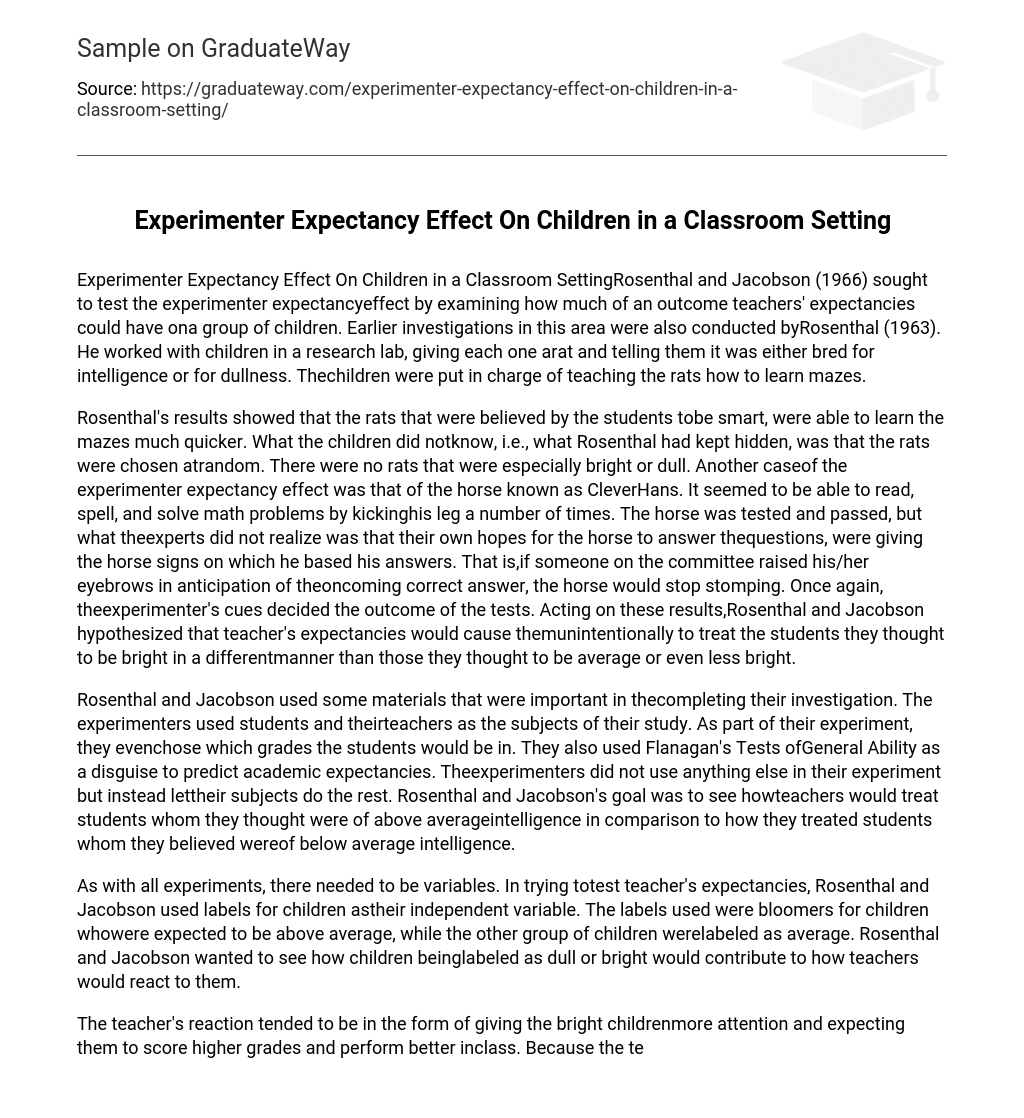Оn Children in a Classroom Settin gRosenthal and Jacobson (1966) sought to test the experimenter expectancyeffect by examining how much of an outcome teachers’ expectancies could have ona group of children. Earlier investigations in this area were also conducted byRosenthal (1963). He worked with children in a research lab, giving each one arat and telling them it was either bred for intelligence or for dullness. Thechildren were put in charge of teaching the rats how to learn mazes.
Rosenthal’s results showed that the rats that were believed by the students tobe smart, were able to learn the mazes much quicker. What the children did notknow, i.e., what Rosenthal had kept hidden, was that the rats were chosen atrandom. There were no rats that were especially bright or dull. Another caseof the experimenter expectancy effect was that of the horse known as CleverHans. It seemed to be able to read, spell, and solve math problems by kickinghis leg a number of times. The horse was tested and passed, but what theexperts did not realize was that their own hopes for the horse to answer thequestions, were giving the horse signs on which he based his answers. That is,if someone on the committee raised his/her eyebrows in anticipation of theoncoming correct answer, the horse would stop stomping. Once again, theexperimenter’s cues decided the outcome of the tests. Acting on these results,Rosenthal and Jacobson hypothesized that teacher’s expectancies would cause themunintentionally to treat the students they thought to be bright in a differentmanner than those they thought to be average or even less bright.
Rosenthal and Jacobson used some materials that were important in thecompleting their investigation. The experimenters used students and theirteachers as the subjects of their study. As part of their experiment, they evenchose which grades the students would be in. They also used Flanagan’s Tests ofGeneral Ability as a disguise to predict academic expectancies. Theexperimenters did not use anything else in their experiment but instead lettheir subjects do the rest. Rosenthal and Jacobson’s goal was to see howteachers would treat students whom they thought were of above averageintelligence in comparison to how they treated students whom they believed wereof below average intelligence.
As with all experiments, there needed to be variables. In trying totest teacher’s expectancies, Rosenthal and Jacobson used labels for children astheir independent variable. The labels used were bloomers for children whowere expected to be above average, while the other group of children werelabeled as average. Rosenthal and Jacobson wanted to see how children beinglabeled as dull or bright would contribute to how teachers would react to them.
The teacher’s reaction tended to be in the form of giving the bright childrenmore attention and expecting them to score higher grades and perform better inclass. Because the teacher’s reaction depends on how the children were labeled,it was dependent on the first variable. The teacher’s reactions to thechildren’s labels, was the experimenter’s dependent variable.
Rosenthal and Jacobson controlled every aspect of the experiment. Theychose which children would be seen as dull or bright by having scores fromFlanagan’s Test of General Ability sent to the teachers. They also chose whichgrades of children would be used and which teachers would be in the experiment.
The experimenters maintained a high degree of control, and they told no one elseof what they were really studying.
The children in the experimental group averaged 12.2 points ofimprovement in their intellectual growth. The students in the control groupaveraged 8.2 points of intellectual growth. Reporting the average is not anaccurate way of showing the difference in IQ point increases though. The thirdthrough sixth grade reported almost no difference in the gains, but the firstand second grades differed as much as 15 points. The difference in scores showsthe effect that teachers can have on their students. Particularly in the firstand second grades, the amount that teachers expect from their students is theamount they will receive.
This study could be improved in a few ways. First, the students weretested at the end of the school year with the same test they had been given toinitially decide their IQs. A different test of intelligence should be given tothe students. Being given the same test, some of the students may be given thesame questions which is an unfair advantage to them because they will know theanswers from the previous test. Another way to improve the study would be byhaving the study performed in both private and public schools and by starting itin preschool and ending it at eighth grade in stead of sixth.
Because of this survey, a consequent study was performed by Chaiken,Sigler, and Derlega (1974). They set up a camera in a classroom in whichteachers had been informed that some of the students were gifted while otherswere dull. The recording showed that teachers tended to smile more at thesupposedly gifted students, acted more favorably to their comments in class, andmade more eye contact with them. Other new research that could be performedwould be a study to see what would happen if a teacher was told his/her entireclass was either gifted or dull and see how they react to an entire class likethat.
I have learned a lot from this article. Having a desire to become ateacher, this article has shown me just how much of a reaction my attention tostudents may have on them. I would like to become a high school or collegeprofessor. Even though Rosenthal and Jacobson’s experiment revealed that theolder the children, the less they were affected by the teacher’s expectancies, Iwould like to see the same experiment performed on high school children. Thiswould reinforce Rosenthal and Jacobson’s findings and take some pressure awayfrom how teachers feel they have to react to older students.





